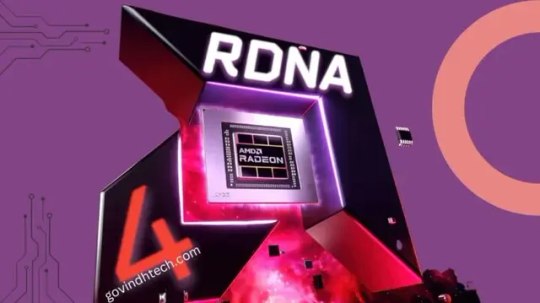#AMDRDNA
Text
AMD RDNA 4: The Next Frontier in Gaming Performance

AMD RDNA 4 GPU
AMD and Nvidia compete in the GPU industry, pushing performance and efficiency ahead. After the success of RDNA 2, gamers and developers are eagerly awaiting AMD RDNA 4 architecture. RDNA 4’s possible features and gameplay influence will be examined here.
Expanding upon a Robust Base
AMD made great progress with the Radeon RX 6000 series‘ RDNA 2 architecture. Over the previous generation, it improved performance, ray tracing, and power efficiency. With even more stunning visuals and more fluid gameplay, AMD RDNA 4 seeks to capitalise on this success.
Production Process A Possible Change
AMD RDNA 4 may employ a 5nm or 4nm TSMC technology instead of 7nm like RDNA 2. Due to miniaturization, more transistors can fit in the same space, potentially:
Gains in Performance
A higher transistor density may result in faster clock rates and better performance all around.
Better Efficiency
A smaller manufacturing process can improve power efficiency, boosting performance without increasing power usage.
Innovation Legacy Building
The company’s RDNA 2 architecture changed AMD. It finally challenged Nvidia’s high-end GPU dominance with noticeable performance increases over the previous generation. RDNA 2 exposed more gamers to hardware-accelerated ray tracing, which simulates realistic lighting effects. AMD RDNA 4 improves on this accomplishment by increasing graphical fidelity and performance.
New Developments in Architecture Revealing the Secrets
Details are yet unknown, however leaks and industry insider knowledge point to a number of possible architectural enhancements in AMD RDNA 4:
Compute Unit Revamp
A redesign of the Compute Units (CUs), the fundamental component of RDNA GPUs, is possible. In order to achieve more realistic lighting effects without compromising performance, this would entail streamlining the pipeline for quicker processing and maybe adding technologies like hardware-based ray tracing acceleration.
AMD’s groundbreaking Infinity Cache technology, which keeps frequently requested data on-chip for quicker retrieval, may be improved even more in AMD RDNA 4. In situations when a lot of data is being processed, such as in complex gaming worlds with high-resolution textures, this could result in lower latency and better performance.
Next-Gen Display Support
There is a chance that advanced display technologies like DisplayPort 2.1 will be supported. With broader colour gamuts and high refresh rates (up to 8K 165Hz), this would enable features that would make for a more immersive and visually attractive gaming experience.
GDDR6 or a Bold Leap to GDDR7 the Memory Conundrum?
Rumour has it that AMD RDNA 4 will use a different form of memory. There are reports indicating AMD may continue to use GDDR6, possibly with greater rates to make up for the absence of GDDR7. There are those who predict that AMD may switch to GDDR7, which has a far better capacity than GDDR6. Cost, availability, and the overall performance objectives for AMD RDNA 4 will probably play a role in the final decision. A major performance boost could be obtained by switching to GDDR7, but doing so could also increase production costs and affect the ultimate price point that consumers pay.
AMD RDNA 4 Release Date
It’s difficult to anticipate AMD RDNA 4’s release date and price based on the scant official information available. But here’s a scenario that could happen based on historical trends and business cycles:
Release Date
The latter part of 2024 appears to be a suitable window, possibly coinciding with important trade shows like Genesco or IFA.
Cost
The cost of the memory configuration and performance enhancements will probably have an impact on the price. Some predict a minor price rise over RDNA 2 GPUs due to the possibility of higher manufacturing costs with upgraded nodes.
The Rivalry Environment Struggling for Superiority
Without a doubt, the release of AMD RDNA 4 will cause a stir in the graphics card industry. Here’s how it could affect the rivalry:
Reaction from Nvidia
Nvidia is probably going to respond with their upcoming architecture, which is supposedly codenamed “Lovelace.” This will encourage healthy competition, encouraging innovation and the delivery of ever-more-powerful GPUs by both businesses.
Gamers will profit from a greater selection of high-performance alternatives at possibly more affordable pricing points.
Performance improvements could promote VR and AR adoption by creating smoother and more immersive experiences.
The Wider Effects of AMD RDNA 4
AMD RDNA 4 is more than just a game platform. Here are a few possible uses:
Content Creation
Producers that use intensive software such as animation, 3D rendering, and video editing can gain from increased performance.
Machine learning and artificial intelligence
AMD RDNA 4 GPUs may be used to speed up workloads related to machine learning and AI.
Read more on govindhtech.com
0 notes
Text

AMD officially introduced RADEON RX 7000 SERIES
Built on the groundbreaking AMD RDNA 3 architecture with chiplet technology, AMD Radeon RX 7900 Series graphics deliver next-generation performance, visuals, and efficiency.
4K and Beyond Gaming
Built on AMD RDNA 3 Architecture
AMD Radiance Display Engine and DisplayPort 2.1 Up to 8K 165Hz
Up to 24GB of GDDR6 memory and blazing fast clock speeds
& Much more…
RADEON RX 7900 XTX will cost $999, and the XT version is $100 cheaper at $899 will be available from - Dec 13, 2022
#AMDGPU#AMDGraphicsCard#AMDRDNA#RDNA3#AMDRADEON#RADEONRXGPU#RX7900#RADEONRXSeries#DesktopGPU#GamingInfoAndNews#Gaming#AMD#Lazyajju
0 notes